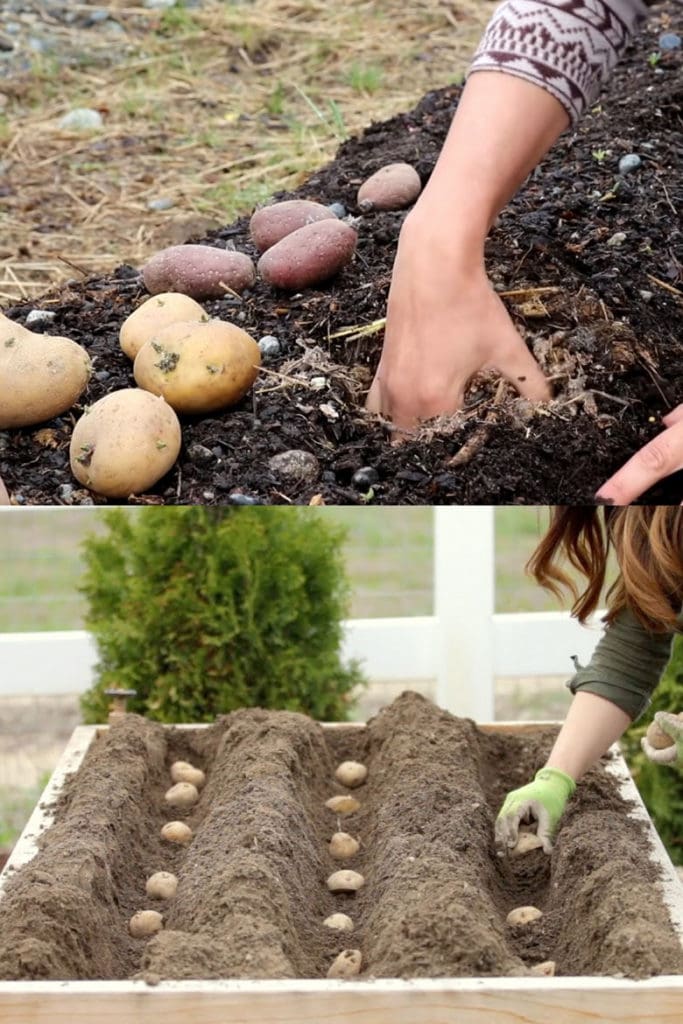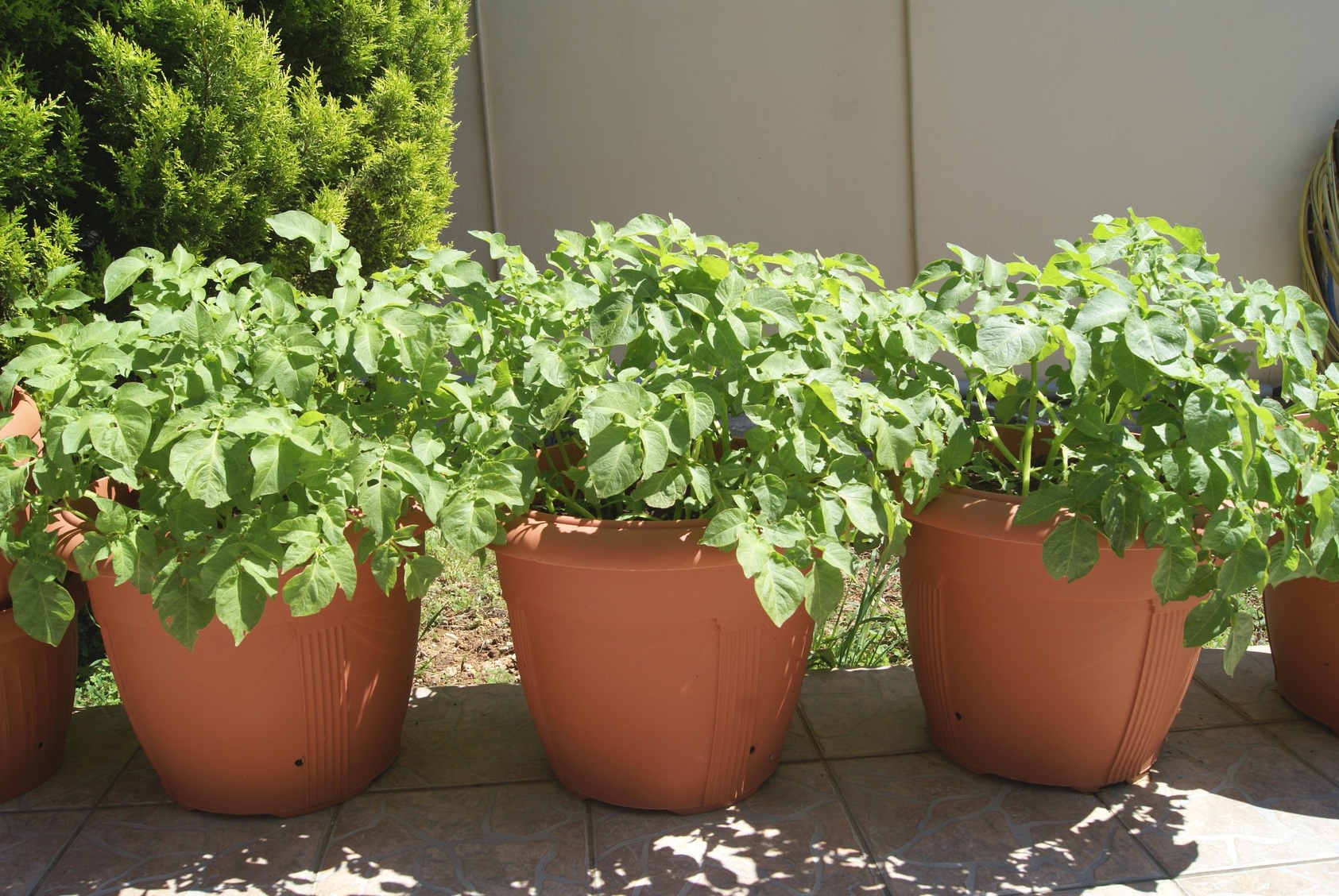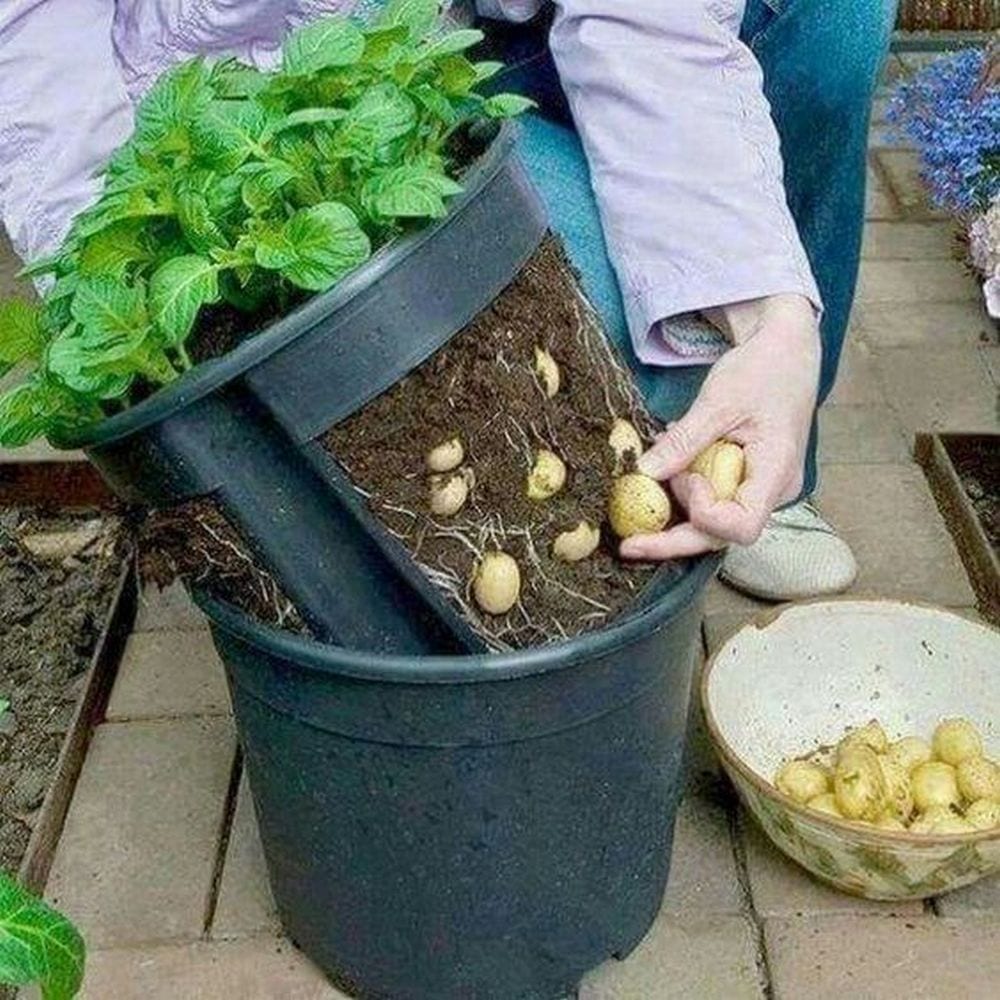The Benefits of Growing Potatoes in Pots
Growing potatoes in containers is an excellent way to cultivate delicious and nutritious potatoes, even in small gardens or urban spaces. One of the primary advantages of container gardening is its space-saving nature, allowing individuals to grow their favorite vegetables in limited areas. By growing potatoes in pots, gardeners can make the most of their available space and enjoy a bountiful harvest.
Another significant benefit of growing potatoes in containers is the improved soil quality. Container gardens allow for better soil structure and drainage, which is essential for healthy potato plant growth. Additionally, container gardens can be easily moved to different locations, making it possible to optimize sunlight and temperature conditions for optimal growth.
Container gardening also offers increased yields compared to traditional gardening methods. By providing optimal growing conditions and careful attention, gardeners can expect higher yields from their potato plants. Furthermore, container gardens can be used to grow multiple varieties of potatoes, allowing for a diverse and exciting harvest.
For those new to gardening, growing potatoes in pots is an excellent way to start. It’s a relatively low-maintenance and forgiving process, making it perfect for beginners. With the right container, soil, and care, anyone can successfully grow delicious potatoes in pots. Whether you’re a seasoned gardener or just starting out, growing potatoes in containers is an excellent way to enjoy the many benefits of homegrown produce.
Choosing the Right Variety for Container Growing
When it comes to growing potatoes in containers, selecting the right variety is crucial for success. With so many varieties to choose from, it’s essential to consider factors such as climate, growing conditions, and desired harvest period. Some popular varieties for container growing include ‘Nicola’ and ‘Charlottes’, which are known for their high yields and compact growth habits.
‘Nicola’ potatoes are a popular choice for container growing due to their high yields and resistance to disease. They have a compact growth habit, making them ideal for smaller containers, and produce a high number of tubers per plant. ‘Charlottes’ potatoes, on the other hand, are known for their creamy texture and sweet flavor. They are also compact and produce a high yield, making them an excellent choice for container growing.
When choosing a variety for container growing, consider the specific growing conditions in your area. If you live in a cooler climate, look for varieties that mature quickly, such as ‘Nicola’ or ‘Pentland Javelin’. If you live in a warmer climate, consider varieties that are resistant to heat stress, such as ‘Charlottes’ or ‘Maris Peer’.
It’s also essential to consider the desired harvest period when choosing a variety. If you want to harvest your potatoes in the summer, look for varieties that mature quickly, such as ‘Nicola’ or ‘Pentland Javelin’. If you want to harvest your potatoes in the fall, consider varieties that mature later, such as ‘Charlottes’ or ‘Maris Peer’.
Ultimately, the key to success when growing potatoes in containers is to choose a variety that is well-suited to your specific climate and growing conditions. By selecting the right variety, you can enjoy a bountiful harvest of delicious and nutritious potatoes.
Preparing the Perfect Container and Soil
When it comes to growing potatoes in containers, selecting the right container size and material is crucial for success. A container that is too small can lead to poor yields and stunted growth, while a container that is too large can be wasteful and inefficient. A good rule of thumb is to choose a container that is at least 6-8 inches deep and has a diameter of 12-18 inches.
The material of the container is also important. Look for containers made from breathable materials such as terracotta, ceramic, or wood. These materials allow for good drainage and aeration, which are essential for healthy potato plant growth. Avoid using containers made from plastic or metal, as they can retain too much heat and moisture.
Good drainage and aeration are essential for healthy potato plant growth. To ensure good drainage, make sure the container has drainage holes in the bottom. You can also add a layer of broken pottery or small rocks at the bottom of the container to improve drainage.
Creating a well-balanced potting mix specifically designed for potatoes is also crucial. A good potting mix should contain a combination of peat moss, compost, and perlite or vermiculite. Peat moss helps to retain moisture, while compost provides essential nutrients. Perlite or vermiculite helps to improve drainage and aeration.
To create a well-balanced potting mix, combine 2 parts peat moss, 1 part compost, and 1 part perlite or vermiculite. Mix well and add a small amount of fertilizer specifically designed for potatoes. Avoid using regular garden soil, as it can compact and prevent proper drainage.
By selecting the right container size and material, and creating a well-balanced potting mix, you can provide your potato plants with the best possible growing conditions. This will help to ensure a healthy and productive harvest, and make growing potatoes in containers a fun and rewarding experience.
How to Plant Seed Potatoes in Containers
Planting seed potatoes in containers is a straightforward process that requires some basic preparation and attention to detail. To get started, you’ll need to obtain seed potatoes that are specifically certified for container growing. These seed potatoes are usually smaller and more compact than regular seed potatoes, and are designed to produce a higher yield in smaller spaces.
Before planting, it’s essential to chit the seed potatoes. Chitting involves allowing the seed potatoes to sprout in a light, cool place for 2-4 weeks before planting. This helps to encourage the seed potatoes to produce more tubers and improves the overall yield. To chit the seed potatoes, place them in a light, cool place with the “eyes” facing upwards. Keep the seed potatoes moist but not waterlogged, and wait for them to sprout.
Once the seed potatoes have chitted, it’s time to plant them in the container. Plant the seed potatoes at a depth of 2-3 inches, with the “eyes” facing upwards. Space the seed potatoes 6-8 inches apart, depending on the variety and the size of the container. Cover the seed potatoes with a layer of potting mix, and water well.
After planting, it’s essential to provide the seed potatoes with adequate water and nutrients. Water the seed potatoes regularly, but avoid overwatering, which can lead to rot and other problems. You can also add a balanced fertilizer to the potting mix to provide the seed potatoes with essential nutrients.
As the seed potatoes grow, you’ll need to hill the soil around the base of the plants. This involves adding a layer of potting mix around the base of the plants, leaving only a few inches of the leaves exposed. This helps to encourage the seed potatoes to produce more tubers and improves the overall yield.
By following these simple steps, you can successfully plant seed potatoes in containers and enjoy a bountiful harvest of delicious homegrown potatoes.
Caring for Your Potato Plants in Pots
Once your potato plants are established in their containers, it’s essential to provide them with the right care to ensure a healthy and productive harvest. One of the most critical factors in caring for your potato plants is providing adequate sunlight. Potato plants require at least 6 hours of direct sunlight per day, so make sure to place your containers in a sunny location.
Watering is also crucial when growing potatoes in containers. Make sure to water your plants regularly, but avoid overwatering, which can lead to rot and other problems. A good rule of thumb is to water your plants when the top inch of soil feels dry to the touch.
In addition to sunlight and water, your potato plants will also require nutrients to grow and thrive. You can provide these nutrients by adding a balanced fertilizer to the potting mix. Look for a fertilizer that is specifically designed for potatoes, and follow the instructions on the label for application rates.
Hilling the soil around the base of the plants is also an essential part of caring for your potato plants. This involves adding a layer of potting mix around the base of the plants, leaving only a few inches of the leaves exposed. This helps to encourage the plants to produce more tubers and improves the overall yield.
Pest and disease control is also important when growing potatoes in containers. Keep an eye out for signs of pests or diseases, such as aphids, whiteflies, or powdery mildew. If you notice any problems, take action quickly to prevent them from spreading.
Finally, make sure to monitor your plants regularly for signs of stress or nutrient deficiencies. If you notice any problems, take action quickly to address them. With proper care and attention, your potato plants should thrive in their containers and provide you with a bountiful harvest.
Common Challenges and Troubleshooting Tips
While growing potatoes in containers can be a rewarding experience, there are some common challenges that may arise. One of the most common issues is potato scab, a bacterial disease that can cause lesions on the tubers. To prevent potato scab, make sure to use disease-free seed potatoes and maintain good sanitation practices.
Wireworms are another common pest that can affect potatoes grown in containers. These pests can cause damage to the tubers and reduce yields. To control wireworms, use a combination of cultural and chemical controls, such as crop rotation and insecticides.
Nutrient deficiencies can also be a problem when growing potatoes in containers. Make sure to use a well-balanced fertilizer that is specifically designed for potatoes, and follow the instructions on the label for application rates.
Other common issues that may arise when growing potatoes in containers include overwatering, underwatering, and exposure to extreme temperatures. To prevent these problems, make sure to monitor your plants regularly and adjust your care practices as needed.
If you do encounter any problems while growing potatoes in containers, don’t panic. There are many troubleshooting tips and solutions available to help you overcome these challenges. For example, if you notice that your plants are not producing tubers, it may be due to a lack of light or inadequate soil quality. Adjusting your care practices and providing more light or improving soil quality can help to resolve this issue.
By being aware of the common challenges that may arise when growing potatoes in containers, you can take steps to prevent them and ensure a successful harvest. With the right care and attention, you can enjoy a bountiful harvest of delicious homegrown potatoes.
Harvesting Your Homegrown Potatoes
After weeks of careful nurturing, your potato plants are finally ready to harvest. But how do you know when the time is right? The answer lies in the plants themselves. When the tops of the plants begin to yellow and die back, it’s a sign that the tubers are mature and ready to be dug up.
To harvest your potatoes, carefully dig around the plants with a fork, being careful not to damage the tubers. Gently lift the tubers out of the soil, and brush off any excess dirt. If you’re harvesting new potatoes, you can expect to get a few small tubers per plant. If you’re harvesting maincrop potatoes, you can expect to get several larger tubers per plant.
Once you’ve harvested your potatoes, it’s essential to cure them to improve their storage life. To cure your potatoes, place them in a cool, dark place with good ventilation. Allow them to dry for a few days, then store them in a paper bag or breathable container. This will help to keep them fresh for several weeks.
It’s also important to note that not all potatoes are suitable for storage. New potatoes, for example, are best eaten fresh, as they don’t store well. Maincrop potatoes, on the other hand, can be stored for several weeks, making them a great option for winter meals.
By following these simple steps, you can enjoy a bountiful harvest of delicious homegrown potatoes. Whether you’re a seasoned gardener or just starting out, growing potatoes in containers is a fun and rewarding experience that’s sure to bring you joy and satisfaction.
Tips for Success and Future Harvests
With the right techniques and care, growing potatoes in containers can be a rewarding and productive experience. To achieve success with growing potatoes in containers, it’s essential to save seed potatoes for future harvests. This can be done by selecting a few healthy tubers from your current harvest and storing them in a cool, dark place until the next growing season.
Another way to achieve success with growing potatoes in containers is to experiment with different varieties and growing techniques. Try growing different types of potatoes, such as ‘Nicola’ or ‘Charlottes’, to see which ones perform best in your specific climate and growing conditions. You can also experiment with different container sizes and materials, as well as different potting mixes and fertilizers.
In addition to saving seed potatoes and experimenting with different varieties and growing techniques, it’s also essential to keep accurate records of your growing season. This can help you to identify areas for improvement and make adjustments for future harvests. Consider keeping a gardening journal or using a gardening app to track your progress and note any challenges or successes.
Finally, don’t be afraid to try new things and take risks when growing potatoes in containers. This can be a fun and rewarding experience, and it’s a great way to learn and improve your gardening skills. With the right techniques and care, you can enjoy a bountiful harvest of delicious homegrown potatoes and look forward to many successful growing seasons to come.





